House Clearance Hacks: Simplify Your Decluttering Process in 9 Steps
Declutter in 9 Steps
Step 1: Starting Your House Clearance Journey
Embarking on a house clearance journey requires initial planning and goal setting. Begin by defining clear objectives for what you hope to achieve. Do you want to create more space, reduce cleaning time, or curate a more minimalist environment?
Establish categories for items such as ‘keep’, ‘donate’, ‘sell’, and ‘discard’ and set a realistic timeline for when you wish to complete each room. Mentally prepare for the task ahead by envisioning the end result and the peace of mind it will bring. A systematic approach will help make the process more manageable and less overwhelming.
Step 2: Decluttering Room by Room
A room-by-room strategy will enable you to focus your effort in a more concentrated way, while yielding visible results. The more progress you can see, the more motivation you may find to continue. In each space, sort items into predetermined categories.
When encountering sentimental items, weigh their emotional value against the practicality of keeping them. Remember, clearing out clutter can have profound psychological benefits, such as reduced anxiety and a sense of control over your environment.
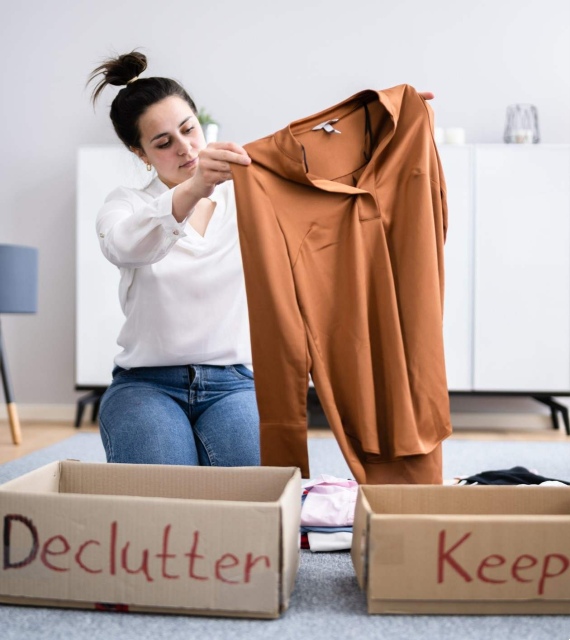
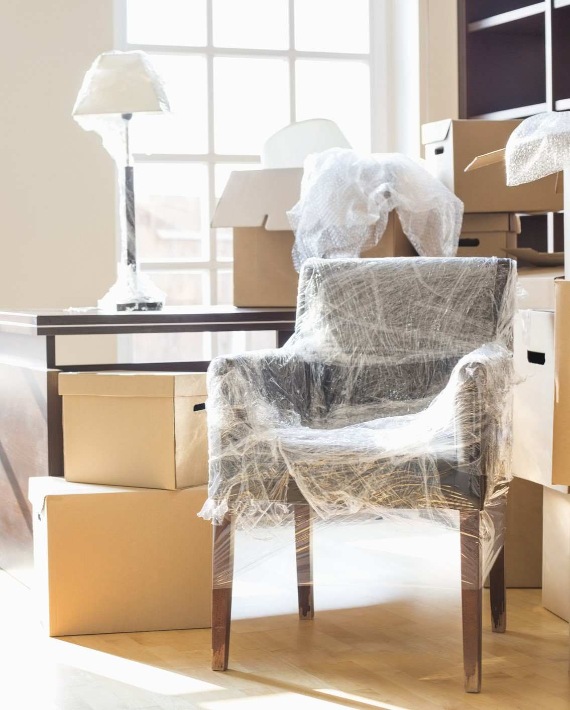
Step 3: Efficient Sorting and Organising Techniques
Once you’re ready to get organised, it’s important to start with a planning technique. Many people have found success using the four-box system—where items are sorted into ‘keep’, ‘donate’, ‘sell’, or ‘trash’. Another popular technique is the KonMari approach, which encourages keeping only those items that ‘spark joy.’. For items you decide to keep, assign them a designated place and use labels and inventory lists to maintain order.
Step 4: Tackling Large and Bulky Items
Larger items can be challenging; evaluate whether they are to be kept, donated, sold, or disposed of. Ensure you handle these items safely to prevent injury and consider enlisting help. The professionals at Mr. Junk are experienced in moving large and cumbersome items, so before you try to tackle these items yourself, call us or chat us for a free evaluation.
Step 5: Selling and Donating Unwanted Items
Selling items can be done through online marketplaces or garage sales. Alternatively, donating to charity can be fulfilling and beneficial to the community. Make a conscious decision between the two, keeping in mind the positive environmental impact of recycling and repurposing items.
Step 6: Digital Decluttering: An Often Overlooked Aspect
Decluttering isn’t limited to physical spaces. Digital clutter can also impact productivity and stress levels. Organise your digital files, photos, and emails. Use methods such as categorising files into clearly labelled folders, regularly archiving old documents, and utilising cloud storage solutions to free up device memory.
Organising photos into albums and deleting duplicates, as well as unsubscribing from unwanted emails and using filters to automatically sort incoming messages, can also help. For an extra boost of help, consider some of the following tools.
File Management and Cleaning
CCleaner: Helps clean up temporary files, browser caches, and other junk that can slow down your computer.
Duplicate File Finder: An app for finding and removing duplicate files to free up space on your computer.
Everything: A lightweight, fast tool to search for files and folders by name on Windows, helping you quickly find and organise your files.
Photo Organisation
Google Photos: Offers cloud storage for photos and videos, with powerful search capabilities and automatic organisation based on date, location, and people in pictures.
Adobe Lightroom: Provides photo management and editing capabilities, allowing users to organise their photo collections efficiently.
Email Management
Unroll.Me: Helps manage your subscriptions by consolidating them into a single daily digest email, making it easier to unsubscribe from unwanted emails.
Mailstrom: An email management tool that identifies bundles of related mail, making it easier to delete or archive them en masse.
Document and Note Organisation
Evernote: A note-taking app that helps you capture and prioritise ideas, projects, and to-do lists, so nothing falls through the cracks.
Notion: An all-in-one workspace where you can write, plan, collaborate, and get organised – it allows you to take notes, add tasks, manage projects & more.
Digital Well-being
Freedom: An app designed to block distracting websites and apps across your devices, helping you focus and be more productive.
StayFocusd: A browser extension for Chrome that restricts the amount of time spent on time-wasting websites.
Step 7: Mindful Disposal and Environmental Considerations
Dispose of items, particularly hazardous materials, responsibly. Lithium batteries, common in electronic devices, pose significant risks if discarded improperly, including fire hazards and pollution. Utilising eco-friendly waste management practices is essential for mitigating these risks.
Utilise recycling centres for items like electronics and batteries to be processed. To ensure eco-friendly disposal, follow these tips:
- Identify and segregate hazardous waste from regular rubbish, including lithium batteries and electronics.
- Use manufacturer take-back schemes for recycling or proper disposal of used electronics and batteries.
- Donate or sell working electronics to extend their lifecycle and reduce waste.
- Adhere to local guidelines for hazardous waste disposal, as provided by municipal waste management services.
- Embrace the three Rs – reduce, reuse, recycle – to minimise waste generation, opting for products with minimal packaging and using rechargeable batteries.
- Participate in community clean-up events or e-waste recycling days organised by local communities for safe disposal.
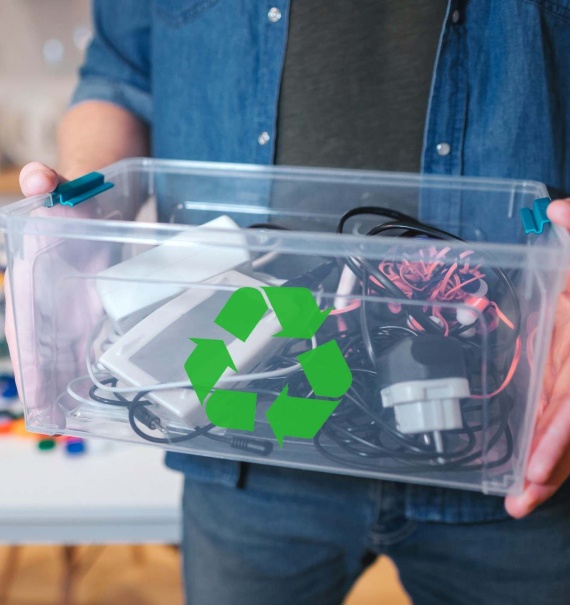
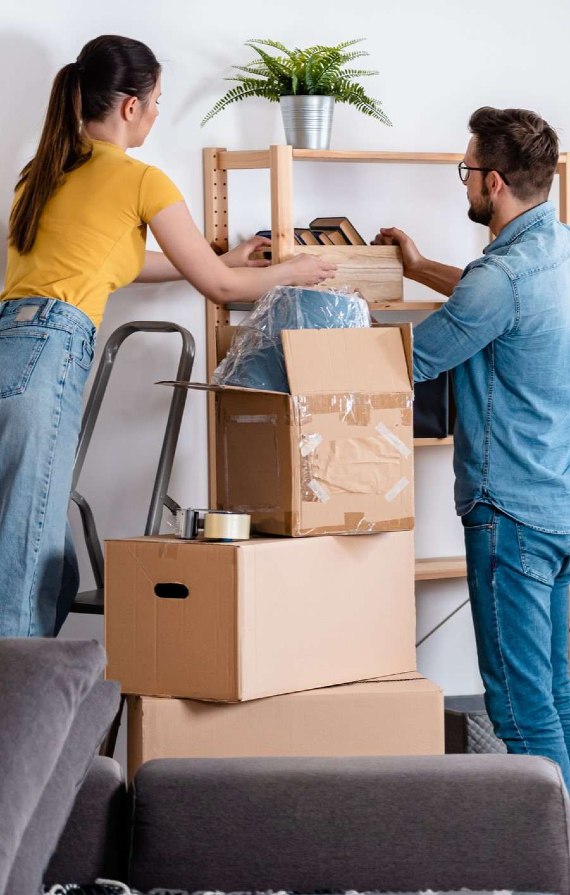
Step 8: Involving Family and Friends for Support
Decluttering can be more enjoyable and efficient with the help of others. It provides an opportunity for bonding and can make the process feel less like a chore. However, it’s important to be considerate of differing opinions on what constitutes clutter. To create a positive and team-oriented process out of what otherwise might be a tedious chore, try these tips:
- Set Clear Goals: Start by defining what you want to achieve with your decluttering session, making sure everyone understands and agrees with the objective.
- Play Music: A shared playlist can keep the atmosphere light and energised, making the task at hand feel less like work.
- Create Mini-Challenges: Turn decluttering into a game by setting up friendly competitions, such as who can fill a box of items to donate first, with small rewards for winners.
- Take Breaks Together: Schedule regular breaks to rest and enjoy snacks or a meal together, keeping spirits high.
- Compromise: Find middle ground on contentious items, such as agreeing to keep something if it can be stored more efficiently or letting go of other items in exchange.
- Use a Voting System: For items that affect everyone, consider using a democratic approach where the majority vote decides its fate, ensuring everyone feels their opinion is valued.
- Acknowledge Efforts: Regularly express gratitude for the help and time your family and friends are contributing. A simple “thank you” can go a long way in making them feel appreciated.
- Celebrate Milestones: Mark the end of a decluttering session or the achievement of a goal with a special treat, such as a meal out or a movie night, to celebrate the progress made together.
- Offer Reciprocity: Show your willingness to help them with their decluttering projects or any other assistance they might need in the future, fostering a culture of mutual support and cooperation.
Step 9: Maintaining a Clutter-Free Home After Clearance
Maintaining a clutter-free environment after an initial clearance can be a rewarding yet challenging endeavour. To ensure the longevity of your efforts, consider integrating the following habits and routines into your daily life:
- Establish a “One In, One Out” Rule
To prevent the re-accumulation of unnecessary items, adopt the “one in, one out” rule. This means for every new item you bring into your home, you should remove an existing item. This practice helps keep your possessions in check and discourages the buildup of clutter.
- Implement Regular Mini-Decluttering Sessions
The importance of regular mini-decluttering sessions cannot be overstated. Set aside a specific time each week or month to go through your belongings and decide what you really need. These sessions don’t have to be lengthy; even 15 to 30 minutes can make a significant difference. Regularly re-evaluating your possessions ensures that clutter doesn’t gradually take over your space again.
- Be Mindful of New Acquisitions
Before purchasing or bringing new items into your home, ask yourself the following questions:
- Do I really need this?
- Do I have a specific place for it in my home?
- Is it replacing something else, or is it just adding to my possessions?
Being mindful of what you acquire can significantly reduce the chances of clutter re-appearing. If you’re unsure about an item, consider waiting a few days before making a decision. This waiting period can help you evaluate whether it’s a need or a momentary desire.
- Create a Dedicated Space for Everything
Ensure that every item in your home has a designated place. This not only helps in keeping your space organised but also makes it easier to notice when things are out of place. When everything has a home, tidying up becomes a more straightforward and less time-consuming task.
- Embrace Digital Solutions
Where possible, opt for digital versions of items to reduce physical clutter. This can apply to books, magazines, bills, and important documents. Digital alternatives can save space and are often more convenient to manage.
- Encourage Household Participation
If you live with others, encourage them to participate in decluttering efforts. Share your goals for a clutter-free home and work together to establish routines that prevent clutter from accumulating. Collective effort can significantly enhance the effectiveness of these strategies.
- Dispose of Unwanted Items Responsibly
When decluttering, consider selling, donating, or recycling items rather than simply throwing them away. This not only benefits the environment but can also help those in need.
By adopting these habits and routines, you can enjoy the benefits of a clutter-free environment over the long term. Remember, the key is consistency and mindfulness in your approach to possessions.
FAQ Section
- What are some effective hacks for starting the house clearance process?
- Start with a plan, set goals, and use the four-box method to categorise items.
- How can I declutter my home without feeling overwhelmed?
- Tackle one room at a time and take breaks as needed.
- What are the best methods for sorting items during decluttering?
- The KonMari method and the four-box system are highly recommended.
- How can I deal with sentimental items during house clearance?
- Evaluate each item’s importance and consider taking photos of items before parting with them.
- What are some safe ways to handle large and bulky items?
- Use proper lifting techniques, get help, or hire a professional service.
- How do I decide whether to sell or donate unwanted items?
- Consider the item’s condition, value, and whether it could benefit someone in need.
- Can digital decluttering improve my daily life?
- Yes, digital decluttering can dramatically enhance productivity and reduce digital stress, leading to overall better mental health.
- What are environmentally friendly ways to dispose of unwanted items?
- Recycle, donate, sell, or use eco-friendly disposal services.
- How can family and friends help in the decluttering process?
- Family and friends can offer practical help, emotional support, and make the decluttering process more enjoyable.
- What can I put in place to maintain a clutter-free home after clearance?
- Regular mini-decluttering sessions and a mindful approach to purchasing new things will help you stay on top of the clutter on a daily basis.
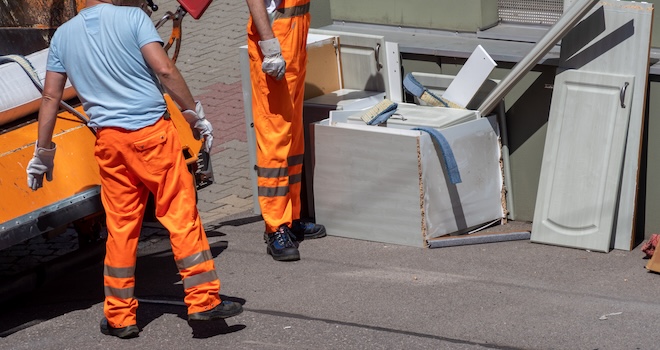
Ready to Declutter with Mr Junk?
If you’re still finding the chore of house clearance and decluttering to be overwhelming, don’t lose hope. The professionals at Mr. Junk are here to help. Our team of professionals is experienced with clearing homes, properties, offices, and more.
No job is too large or small for our team. We do more than just clear out your clutter; we create a clearer, and more spacious living environment for you. Mr. Junk is ready to help you reclaim your space. Call us or chat us today!
